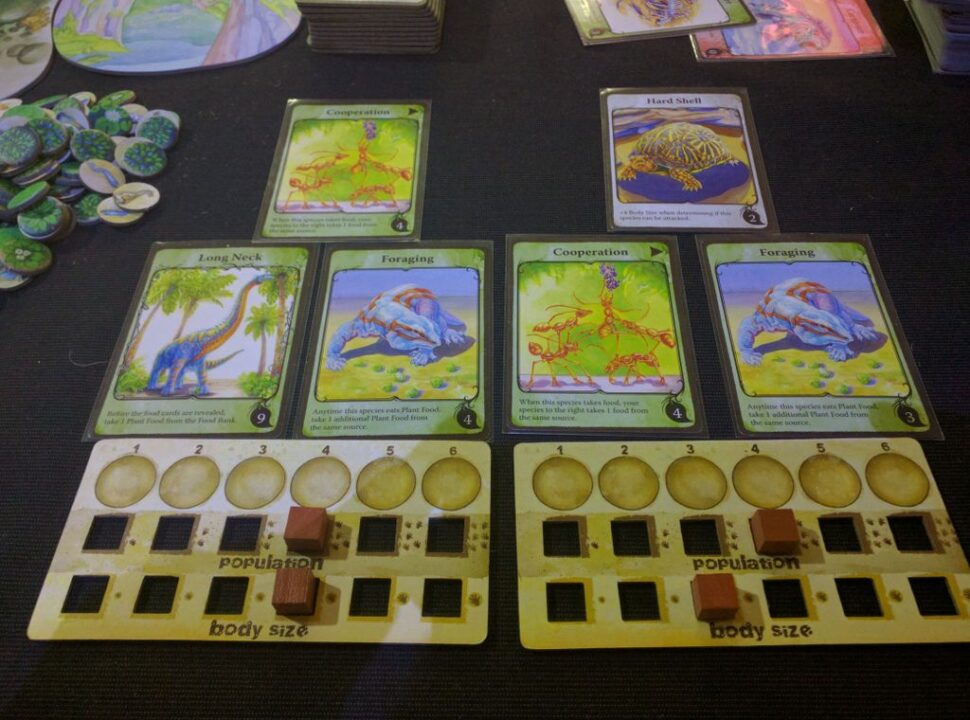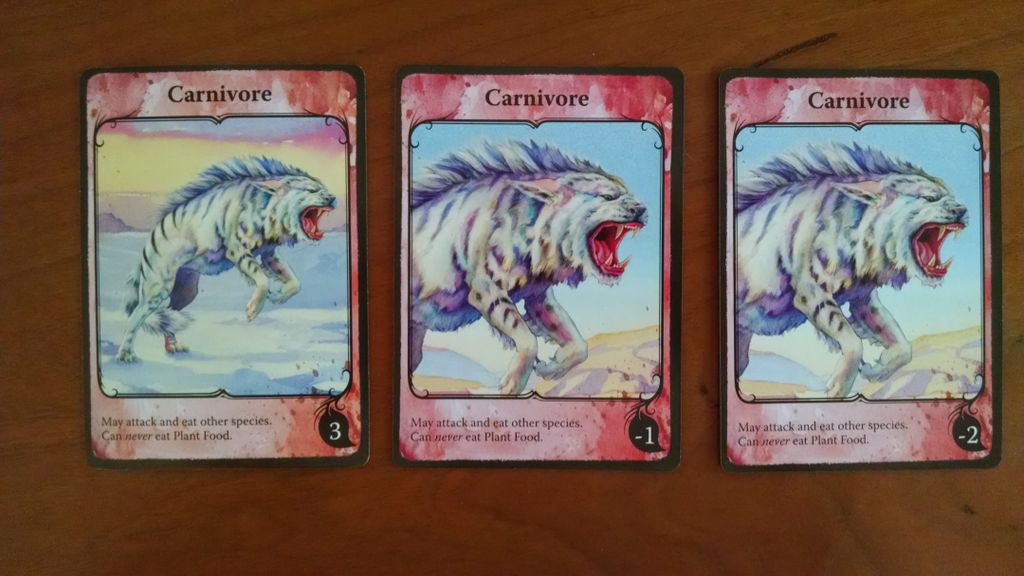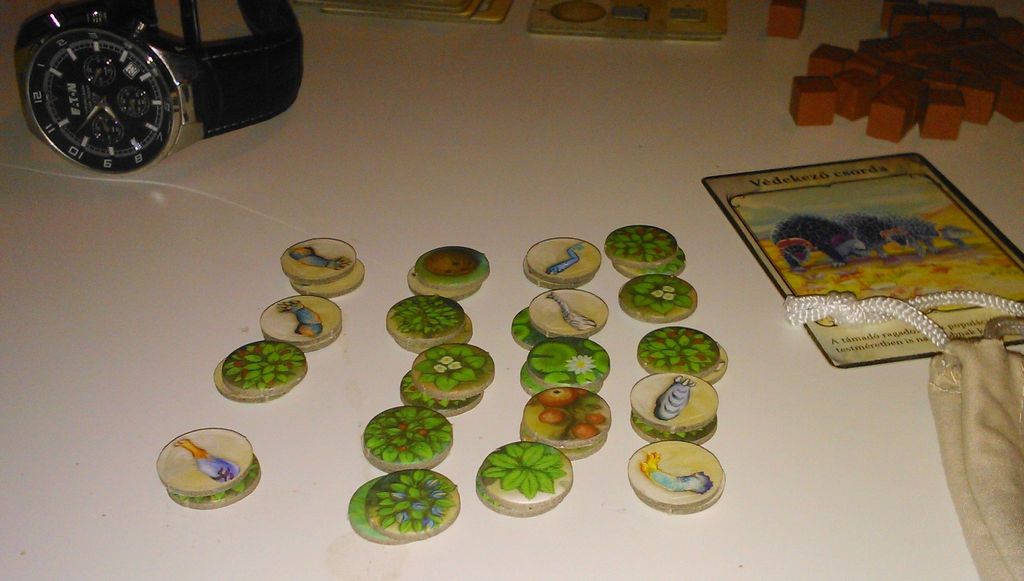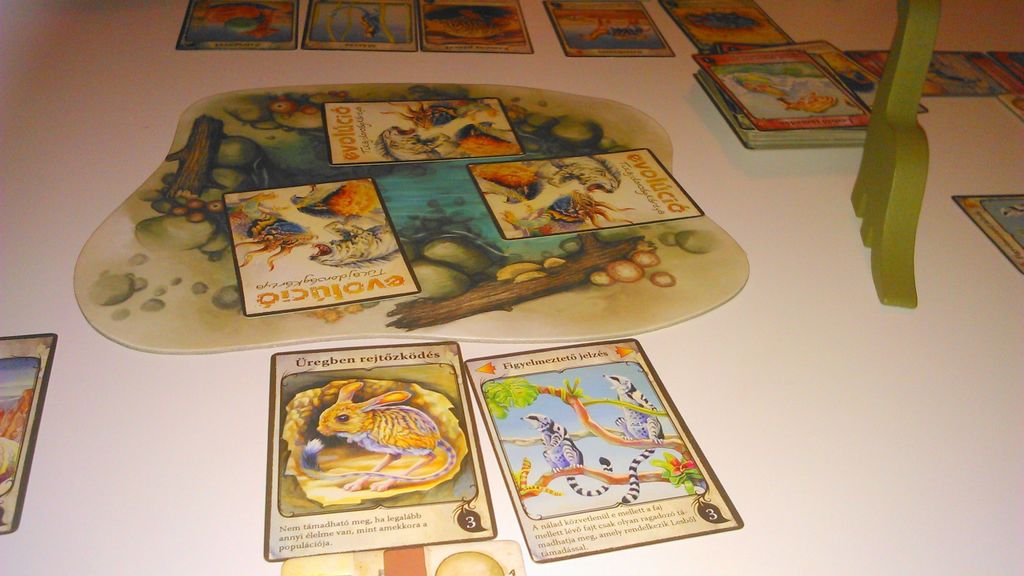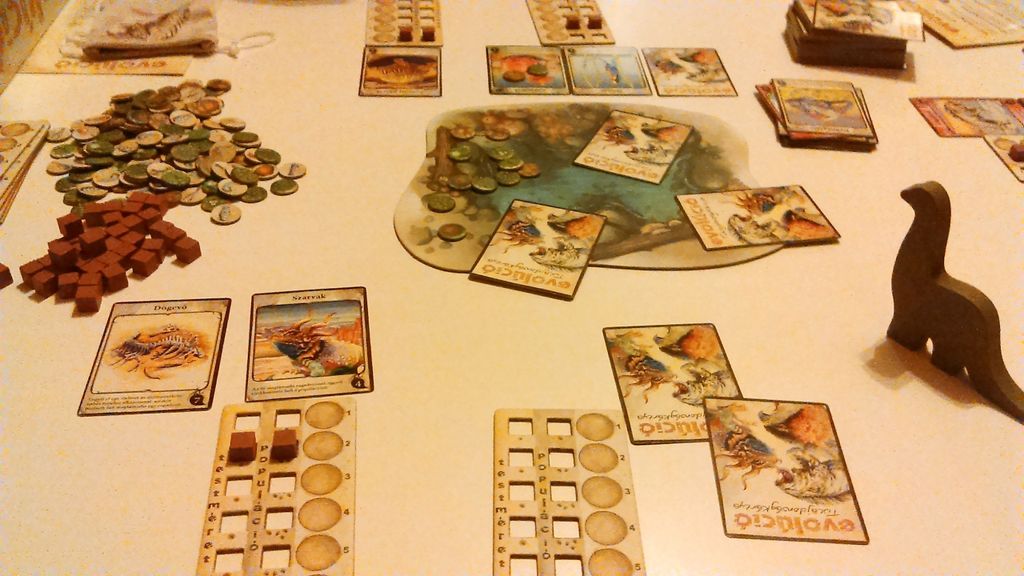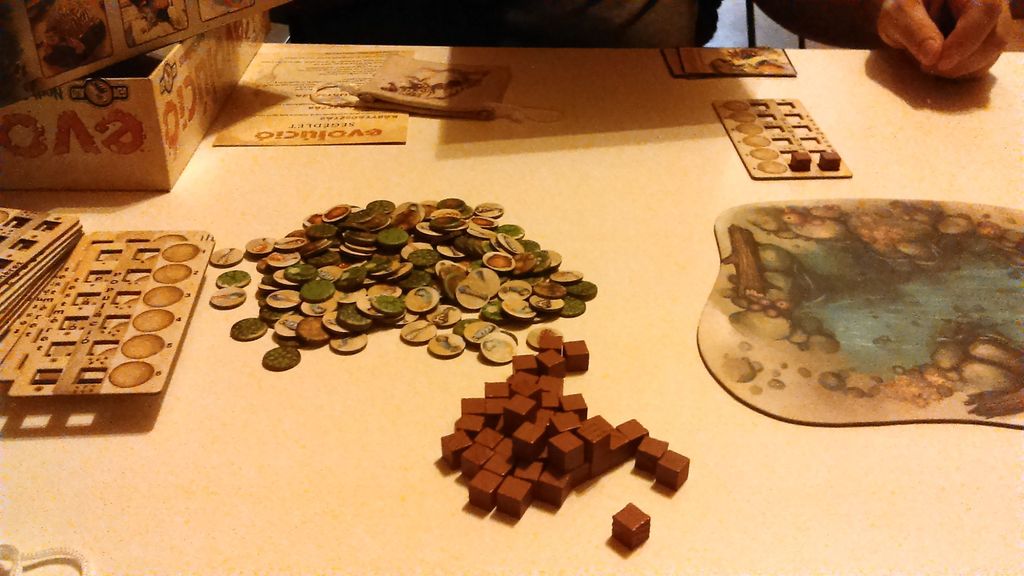Welcome, game lovers and curious minds! Today, we’re diving into the wild world of Evolution, a board game where you’ll morph into a mad scientist of the animal kingdom. This is not just a game review, but a firsthand romp through the glorious chaos that comes with adapting and strategizing your very own species. Stay with me as we explore the nuts and bolts of this evolutionary rollercoaster, covering everything from gameplay mechanics to the vibrant artwork. Spoiler: you might want to set aside a permanent spot on your game shelf for this one.
How It Plays
Setting Up
Start by giving each player a species board and some food tokens. Place the watering hole board in the middle. Deal three trait cards to each player. Place the rest of the trait cards in a draw pile.
Gameplay
Each round is split into phases. First, players add food to the watering hole. Next, players can play trait cards to adapt their species or create new ones. Then, players take turns to feed their species from the watering hole or from their opponents’ species. If a species can’t get enough food, it goes extinct. The game continues until the draw pile is empty.
Winning the Game
At the end of the game, each player counts their food tokens, surviving species, and trait cards. The player with the highest score wins and is declared the master of evolution!
Want to know more? Read our extensive strategy guide for Evolution.
Exciting Gameplay Mechanics in Evolution
Let me tell you, folks, Evolution is a game that gets my gears turning! The gameplay mechanics are the heart of the experience, and boy, do they pump some life into your game night. Imagine you’re a mad scientist of the animal kingdom. You get to create and evolve your species by giving them traits like ‘long necks’, ‘sharp claws’, or ‘scavenger skills’. It’s like Pokémon, but without needing Pikachu to deal with Team Rocket!
Now, the mechanics here are clever. Each turn, you play cards to bolster your species, making them more efficient at feeding, or better at surviving those pesky predators your friends love to unleash. It’s not just about being the biggest and baddest, though! You also need to think strategically about the food chain and environment. I’ve seen games where someone makes a crazy carnivore, only for it to starve because everyone else evolved super defenses. Talk about karma coming back to bite you—literally!
One of the coolest things is how interactions between players add depth. You can’t just sit there in your own little world. You’re constantly watching how others evolve their species, trying to predict their moves, and adjusting your strategy. It’s like a game of chess with fangs and claws! Plus, the mechanics are balanced. No one trait is a catch-all solution, so you’re always juggling between different approaches. However, luck does play a small role with the card draws, which can sometimes be frustrating.
If you enjoy games that make you think and adapt, Evolution will scratch that itch. Stay tuned because next, we are going to explore why this game doesn’t gather dust on the shelf: Replay Value!
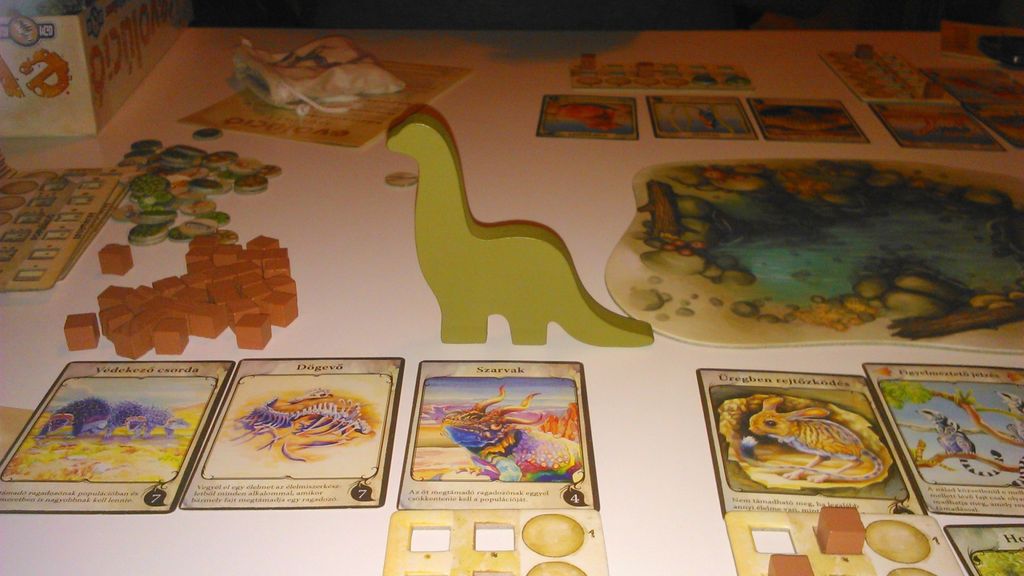
Replay Value in Evolution: A Never-Ending Safari
When it comes to replay value, Evolution is like a box of chocolates—each game brings a different flavor. I’ve played it with my friends more times than I can count, and each session feels like a new adventure. The game’s diverse card pool and ever-changing environments ensure no two games are alike.
Remember that one time when Jeff turned his tiny herbivore into an apex predator with just a few well-timed cards? Or that game where Sara’s scaly critters outsmarted us all by swimming away from the carnivores? These stories keep us coming back for more, eager to outdo each other and create new strategies.
What really gives Evolution its legs is the strategic depth. Each choice, from developing your species to choosing traits, has far-reaching effects. You have to think on your feet and adapt, much like the creatures in the game. It’s this constant adaptation that makes Evolution a game you’ll want to return to over and over.
Still, it’s worth noting that the game can sometimes swing wildly based on the cards you draw. This luck factor might not sit well with everyone, especially if you prefer a game of pure skill. Despite this, the blend of strategy and luck gives Evolution an edge, striking a balance that many find thrilling.
Next section, we’ll look at the Artwork and Components of Evolution, which is basically the game’s fancy feathers and shining scales. Stay tuned!
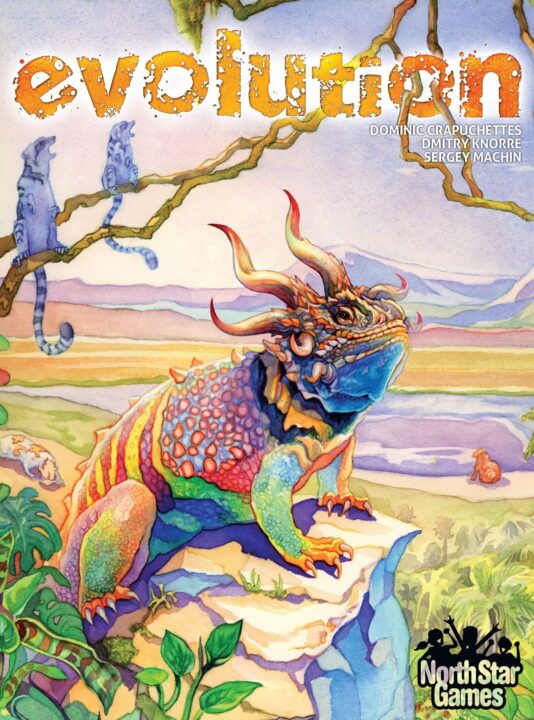
Colorful Artwork and Quality Components in Evolution
When I cracked open Evolution for the first time, I felt like a kid in a candy store. The artwork is vibrant and brings the prehistoric theme to life. The illustrations are not just pretty pictures—each one tells a story of survival and the brutal beauty of natural selection. It’s like National Geographic, but on your game table.
The components are top-notch too. The cards have a nice finish and feel sturdy in your hands. I’ve played this game more times than I can count, and the cards still look fresh out of the box. Kudos to the designers for making something that’s built to last.
The player boards are simple yet effective. They have everything you need right there in front of you. No scrambling to find where to put your food tokens or where to track your species’ population. Speaking of tokens, let’s talk about them—these little wooden bits are charming and easy to handle. It’s great to see a game that doesn’t skimp on the quality of the tactile experience.
Even the rulebook is a work of art. Clear instructions, lots of pictures, and even some humor sprinkled throughout. It makes learning the game a breeze. Plus, it’s got a backstory that adds a bit of flavor to your creature-creating escapades.
If I had to nitpick, I’d say the storage solution isn’t quite perfect. After a few plays, organizing all the bits and pieces back into the box can feel like a game in itself. But hey, that’s a minor quibble in the grand scheme of things.
Next up, let’s look at how Evolution encourages player interaction. You won’t believe the way this game makes you eye your friends like they’re the last piece of pizza.
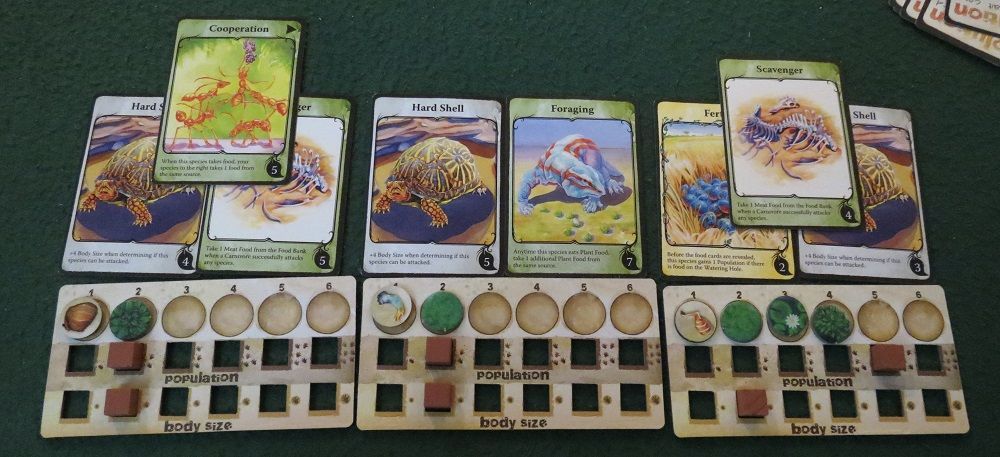
Player Interaction in Evolution: A Game of Survival and Strategy
Evolution is all about survival of the fittest, and you bet that means clashing with other players. The game thrives on competition and adaptation. Every turn, you will watch your friends evolve their species, adding traits that can vastly change the dynamics. You might feel like David Attenborough, but with a more cutthroat attitude.
Want to be the apex predator? You’ll have to evolve carnivorous traits and keep tabs on the other players’ species. It’s like those nature documentaries, but with more trash talk and less beautiful landscapes (though the game art is quite lovely). Player interaction isn’t just encouraged; it’s necessary for survival.
One hilarious moment from my game group was when my friend Sarah thought her herbivores were safe, only for me to evolve a long neck trait that allowed me to munch through the plant supply faster. Chaos ensued, and Sarah’s herbivores had to evolve quickly or face extinction. It’s these unexpected twists that keep us coming back for more.
One downside, though, is that if you’re not careful, you can end up with some major imbalances. If one player’s species becomes too dominant, it can lead to runaway victories. It’s vital to keep a balance and ensure no one player gets too far ahead.
Overall, if you enjoy games with high player interaction and a need for adaptability, Evolution is a solid choice. Just remember: it’s survival of the fittest out there. Do I recommend it? Absolutely, just sharpen your claws and keep your wits about you!
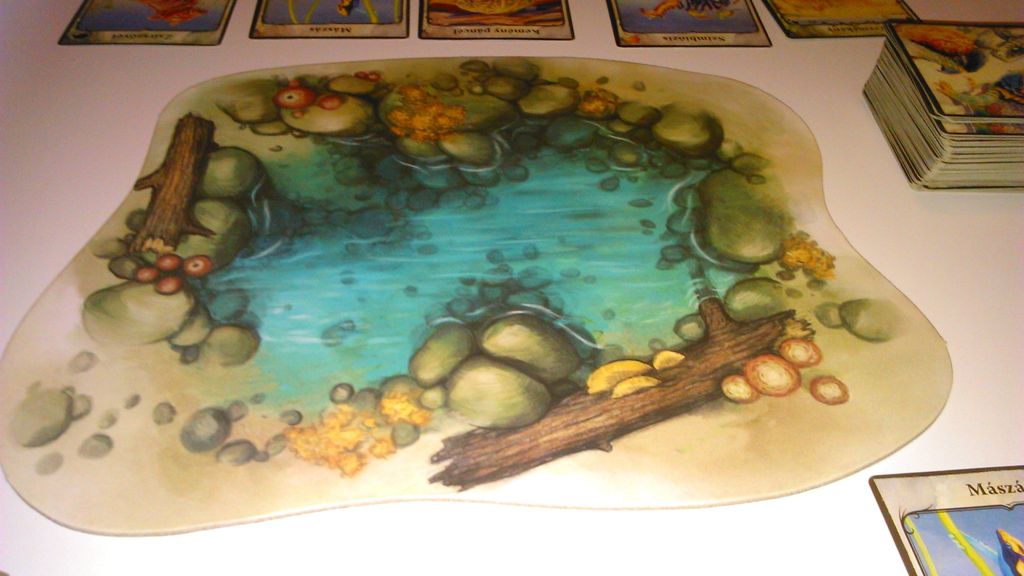
Conclusion
Wrapping up this review, Evolution stands out with its vibrant artwork and top-notch components. The strategic depth and dynamic player interaction make it a fantastic addition to any board game night. However, if you dislike luck-based elements, they may be a slight downside. All in all, Evolution is a wild ride that’s worth the investment.

